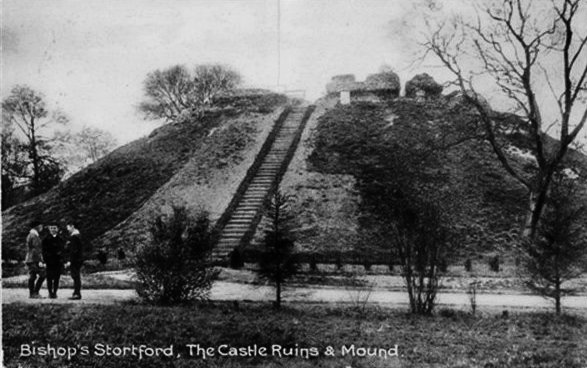Waytemore

A fortress, now within the precincts of the town of
Bishop's Stortford, was possibly built here by King Edward (d.924).
In 921, after he fortified Towcester (Tofeceastre) at Easter, the
king ordered his men to build a stronghold at Wigingamere
at Rogationtide. If this identification is correct, Waytemore
castle began its existence as a burgh. Minor excavations in 1900
found Roman coins in the ruins.
According to Domesday Book (1086), Bishop William of London (1051-75) purchased Bishop Stortford as part of a ‘fee' from King William I
(1066-87). In 1086 it was noted that a priest, 2 knights and 12
cottars lived there. Possibly the knights were associated with
the castles which was granted by the king to Bishop Maurice of London
and his successors as ‘the castle of Stortford and all the land
which Bishop William (d.1075) formerly held' in the period 1086 to
1087.
In 1137 the castle was seized by Abbot Anselm of Bury St Edmunds
(1121-48) in his attempt to make himself bishop of London.
However the castle was soon relinquished when the pope quashed
his election in 1138. In 1141/2 the Empress Matilda bought the support of Geoffrey Mandeville (d.1144) by making him a putative grant of Waytemore castle (castellum de Storteford) if she could acquire it by exchange with the bishop of London, otherwise she would destroy it (prosternere). However, they failed to take the castle from Bishop Robert Sigillo (d.1150) who remained loyal to King Stephen
(1135-54). In 1187, on the death of Bishop Gilbert Foliot, the
castle was taken into the king's hand where it remained until Richard
Fitz Neal (d.1198) became bishop under King Richard I. When the
royal accounts of the administration of the bishopric were drawn up at
Michaelmas 1189 it was recorded that £1 had been spent on a
watchman and the porters at Stortford castle for three quarters of a
year (ie. from September 1188 until June 1189). Further £10
18s 8d had been spent on the serjeants who were in residence at the
manor.
In 1208 Bishop William of London (1196-1221) was one of those who published the interdict against King John
(d.1216) and promptly fled the country. This resulted in the king
seizing Waytemore castle. According to a fourteenth century
chronicle it was only in 1213 that ‘the castle of the bishop of
London at Stortford (Stortteforde)
was destroyed'. The date, however must be wrong, for on 21 July
1213 King John informed all his bailiffs and faithful men that he had
allowed Bishop William of London to rebuild his castle of Stortford
when he wished and that they were not to impede him in this. The
same year, on 22 November, the king went further and acknowledged that
although he had taken the castle during the interdict he was now
willing to repair the castle and restore it to its former
strength. Despite this there is no record that John actually
spent any money on the castle, though it would appear to have been
repaired as on 29 March 1216 the king came to Bishop's Stortford and
stayed overnight. The castle seems to have been used as a prison
by 1234, though why it was then in royal custody is a mystery.
Stortford castle was recorded as in good repair under Edward III
(1327-77) and on 12 March 1346 Bishop Ralph Stratford (1340-54) was
given licence to ‘crenellate his castle of Storteford and the
tower of the same'. On 10 September 1352 it was recorded that
Bishop Ralph had founded a chantry in Storteford
castle. By the fifteenth century the castle was ruinous and by
1545 the bishop's court had moved to Hockerill and the castle by 1549
was no more than a few pieces of walling. The prison near the
site of the castle gatehouse survived until 1649 when it was demolished.
Description
The castle consists of a 40' high mound about 160' east to west and
230' north to south, set in a bend of the River Stort. To the
south is a large bailey, the whole being surrounded by the river to the
north and east, with a moat on the remaining 2 sides. On the
motte top are the remains of what has been described as a shell keep,
but is more of an inner ward with a curtain some 9' thick. This
is about 60' east to west at the south end and a little over 100'
long. The north end, about 70' across, is slightly convex and has
a rectangular building covering the western 2 thirds of the wall and an
otherwise square 16' room the north-east corner. The thin
internal wall contains some Roman bricks and tiles and therefore might
be the oldest masonry on the site. There may have been a stair
turret at its western end. There are further traces of another
roughly square 16' building in the south-east corner of the ward.
However this seems to have had walls about 10' thick and may be the
castle tower or keep. Entrance was always from the bailey to the
south, apparently through a hole in the wall type gate adjacent to the
keep. In this respect it is rather like Lydney. The well in the south-west corner is over 60' deep.
The D shaped bailey has been much mutilated in modern times, but an
excavation in the south western part of the ward uncovered massive
foundations of flint and oolite in a yellow mortar mixed with what may
have been Roman brick.
Copyright©2021
Paul Martin Remfry

